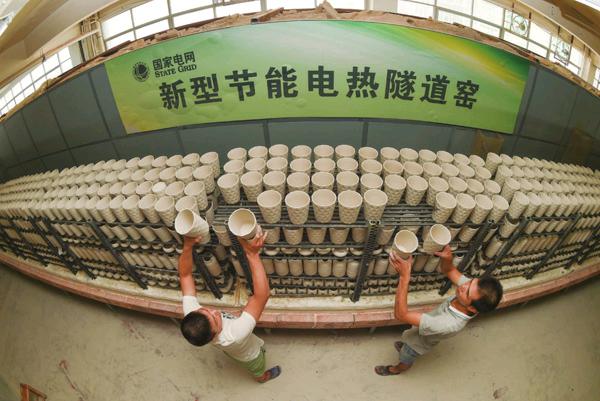Green Legislation
2018-02-01ByDengYaqing
By+Deng+Yaqing
In Laicheng District of Laiwu, an indus-trial city in the center of east Chinas Shandong Province, chemical, iron, steel and cement manufacturers have been bracing themselves for a signifi cant change: On January 1, the countrys first tax designed specifically for environmental protection came into effect.
“Since the Environmental Protection Tax Law was approved at the end of 2016, we have been contemplating how to intensify emission reduction efforts in order to pay fewer taxes,” said Li Yong, production manager of Laiwu Lianyun Cement Co. Ltd., a local cement manufacturer.
In the past year, a total of 20 million yuan ($3.11 million) has been invested in technological improvement, Li explained. For example, the concrete grinders they purchased have helped eliminate half of the companys pollution sources. At the same time, 18 new bag-type dust collectors have enhanced their dust collection efficiency from 98 percent to 99.9 percent, according to Li.
The environmental protection tax, which brought an end to the pollutant discharge fee which China had been collecting for nearly four decades, targets enterprises and public institutions that discharge listed pollutants directly into the environment.
For years, critics have called for the fee system to be replaced with legislation because many local governments had a tendency to exempt those high-polluting enterprises that made major contributions to local GDP growth. Under the new system, companies must pay taxes for producing noise, air and water pollution as well as solid waste, which will then be apportioned to local governments to be put toward efforts to further curb pollution.
Motivating factors
“As local governments are able to keep all the taxes collected from polluters, they are more active in their efforts to prevent and control environmental problems than before,” Lu Kun, an offi cial from the Beijing Local Taxation Bureau, told the Peoples Daily. For example, Beijing collected 613 million yuan ($95.29 million) in pollutant discharge fees in 2016, but air pollution control itself cost 16.56 billion yuan ($2.57 billion), and water resource protection 17.66 billion yuan ($2.75 billion).
“Pegging the environmental protection tax at a higher level can hold polluters more responsible for pollution control,” Lu said.
The central authorities have set lower limits for the tax, and plan to allow local governments to determine rates based on their own respective conditions. Under this system, provincial-level governments can increase the rates for air and water pollution by up to 10 times. According to a statement by the Ministry of Finance, the lowest potential tax rates are 1.2 yuan($0.2) per unit of atmospheric pollution, 1.4 yuan ($0.22) per unit of water pollution, 5 yuan ($0.78) per ton of coal waste and 1,000 yuan ($155.5) per ton of hazardous waste. For different pollution factors, tax rates are set according to the harm they do to the environment. The tax rate for formaldehyde is thus 24 times that of smoke and dust.endprint
“Under this system of calculation, enterprises are more driven to improve technology and reduce pollutant discharge, particularly the most hazardous forms of waste,” said Cai Zili, Director of the Property and Behavior Tax Department of the State Administration of Taxation.
From pollutant discharge fee to environmental protection tax, the changes are not just confined to the name, with the latter more rigidly enforced than the former. Under the previous system, if a company refused to pay the fee or made fraudulent claims about the amount it should pay, then the chances were that it would be issued a relatively small fi ne and production or that business operations might be suspended for a while. However, according to the laws governing taxation in China, if a company is found evading taxes, then the authorities are diligent in extracting payment and have the power to issue penalties ranging from 50 percent to 500 percent of the owed amount, in some cases referring the case to the criminal authorities.
Novel approach
“For years, there has been no category of taxes in China targeted at pollutant discharge or behaviors that are harmful to the ecological environment, which has weakened the role of taxation in environmental protection,” said Liu Shangxi, President of Chinese Academy of Fiscal Sciences, noting the tax wou ld amplify the governments measures to protect the environment and complement broader efforts to combat pollution.
“The point is not how much it will contribute to local fi scal revenue, but how much it will motivate enterprises to tackle pollution,” said Wang Jianfan, director of the tax policy department of the Ministry of Finance, who holds that the environmental protection tax is designed to protect and improve the environment, reduce pollutant discharge and advance China as an ecological civilization.
Those who discharge more pollutants are subject to more taxes, those who discharge less pay less, and those who reduce the concentration of discharged pollutants are eligible to tax reductions or exemptions. Such a mechanism will push enterprises to take into consideration the environmental price when calculating production costs, said Wang, adding that industries which rely on high levels of pollution and energy consumption would be more eager to promote transformation and upgrading.
By unveiling the tax and improving the related legislation, the government aims to raise awareness of environmental protection across society, as well as enterprises sense of responsibility in controlling pollution and cutting emissions, said Liu.endprint
